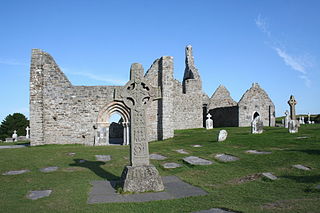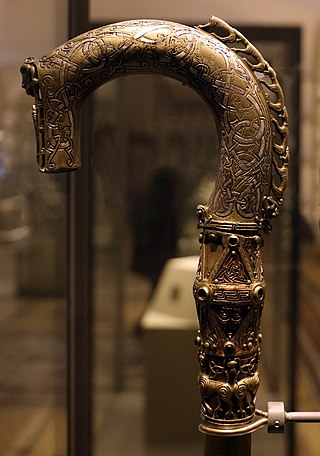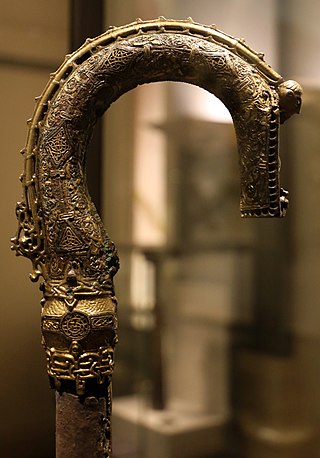Description
St. Mel's Crozier is built from 14 separate metallic parts, with the wooden core lined with silver, gilding, glass and coral. [2] The shaft is 84 cm long. The crook is made from oak, while the drop has a willow core.
The wooden core could be divided into three parts, each now lined with nail holes [3] The collar knope is designed to hold eight decorative stones, of which three survive: two red coral and one blue glass stone. [4] The staff contains a number of secondary nail holes, indicating that it may have been "dismantled and repaired several times in the past". [5]
It is so dated based on the style of the zoomorphic designs, which are similar to those on the Kells Crozier. [2] The drop's metal casting is secondary (of a later date) and has an inset (cavity) to hold a reliquary box, which is now filled with a small block of wood. [6] [7] However the reliquary box is slightly too small for the drop, and was probably also a later addition, likely to replace a similar, slightly larger fitting. [8]

Longford is the county town of County Longford in Ireland. It had a population of 10,952 at the 2022 census. It is the biggest town in the county and about one third of the county's population lives there. Longford lies at the meeting of Ireland's N4 and N5 National Primary Route roads, which means that traffic travelling between Dublin and County Mayo, or north County Roscommon passes around the town. Longford railway station, on the Dublin-Sligo line, is used heavily by commuters.

Clonmacnoise is a ruined monastery situated in County Offaly in Ireland on the River Shannon south of Athlone, founded in 544 by Saint Ciarán, a young man from Rathcroghan, County Roscommon. Until the 9th century it had close associations with the kings of Connacht.

Mél of Ardagh, also written Mel or Moel, was a 5th-century saint in Ireland who was a nephew of Saint Patrick. He was the son of Conis and Patrick's sister, Darerca. Saint Darerca was known as the "mother of saints" because most of her children entered religious life, many were later recognized as saints, and several of her sons became bishops.

The Diocese of Ardagh and Clonmacnoise is a Latin Church diocese of the Catholic Church in Ireland.

The Bishop of Ardagh was a separate episcopal title which took its name after the village of Ardagh, County Longford in Ireland. It was used by the Roman Catholic Church until 1756, and intermittently by the Church of Ireland until 1839.

The United Dioceses of Kilmore, Elphin and Ardagh is a diocese of the Church of Ireland located in central Ireland. It is in the ecclesiastical province of Armagh.

The Cathedral Church of St Mel is the cathedral church of the Roman Catholic Diocese of Ardagh and Clonmacnoise, located in the town of Longford in Ireland. Built between 1840 and 1856, with the belfry and portico as later additions, it has been considered the "flagship cathedral" of the Irish midlands region, Longford's "landmark building" and "one of the finest Catholic churches in Ireland". The cathedral is dedicated to Saint Mél, who came to Ireland with Saint Patrick and who was ordained bishop at Ardagh, County Longford.
St Mel's College is an all-boys secondary school in Longford, Ireland.
Colm O'Reilly is an Irish prelate of the Catholic Church. He served as the Bishop of Ardagh and Clonmacnoise from 1983 to 2013.

The National Museum of Ireland – Archaeology is a branch of the National Museum of Ireland located on Kildare Street in Dublin, Ireland, that specialises in Irish and other antiquities dating from the Stone Age to the Late Middle Ages.

The Cathedral of Saint Mell is the name given to the ruins of a small, Early Medieval church in the village of Ardagh, County Longford in Ireland, not to be confused with St Mel's Cathedral in the town of Longford. Church reform in the 12th century made Saint Mel's Cathedral in Ardagh the centre of the Diocese of Ardagh and Clonmacnoise, demonstrating the importance of the site as a Cathedral and bishopric see. Although known as Saint Mel's Cathedral, the ruined church dates from three centuries after the saint's death, and predates the introduction of a diocesan system in Ireland.

The Kells crozier or British Museum Crozier is an early medieval Irish Insular crozier. It is often known as the "Kells Crozier", indicating an associating with the Abbey of Kells, although no evidence of this exists, and most historians accept that it is of uncertain providence. The crozier is fully intact, although some of the ornamentation is in poor condition.

The Shrine of Miosach is an elaborately ornamented 11th-century Irish cumdach. It originates from Clonmany, north County Donegal, and is first mentioned in the 1165 Irish annals. It is dated to the late 11th century, when it probably contained a manuscript with psalms or extracts from a Gospel. However, the shrine was empty when first described in detail in the 18th century. It was originally associated with St Cairneach, patron saint of Dulane, County Meath, but by the late medieval period had become part of the cult of the abbot and missionary Colm Cille.

House-shaped shrine are early medieval portable metal reliquary formed in the shape of the roof of a rectangular building. They originate from both Ireland and Scotland and mostly date from the 8th or 9th centuries. Typical example consist of a wooden core covered with silver and copper alloy plates, and were built to hold relics of saints or martyrs from the early Church era; a number held corporeal remains when found in the modern period, presumably they were parts of the saint's body. Others, including the Breac Maodhóg, held manuscripts associated with the commemorated saint. Like many Insular shrines, they were heavily reworked and embellished in the centuries following their initial construction, often with metal adornments or figures influenced by Romanesque sculpture.

An Insular crozier is a type of processional bishop's staff (crozier) produced in Ireland and Scotland between 800 and 1200. Such items can be distinguished from mainland European types by their curved and open crooks, and drop. By the end of the 12th century, production of Irish croziers had largely ended, but examples continued to be reworked and added to throughout the Romanesque and Gothic periods. Although many of the croziers are associated with 5th- and 6th-century saints, the objects were not made until long after the saints had died. A majority originate from around the 9th century, with a number further embellished between the 11th and 13th centuries.

The Clonmacnoise Crozier is a late-11th-century Insular crozier that would have been used as a ceremonial staff for bishops and mitred abbots. Its origins and medieval provenance are unknown. It was likely discovered in the late 18th or early 19th century in the monastery of Clonmacnoise in County Offaly, Ireland. The crozier has two main parts: a long shaft and a curved crook. Its style reflects elements of Viking art, especially the snake-like animals in figure-of-eight patterns running on the sides of the body of the crook, and the ribbon of dog-like animals in openwork that form the crest at its top. Apart from a shortening to the staff length and the loss of some inserted gems, it is largely intact and is one of the best-preserved surviving pieces of Insular metalwork.

The Lismore Crozier is an Irish Insular-type crozier dated to between 1100 and 1113 AD. It consists of a wooden tubular staff lined with copper-alloy plates; embellished with silver, gold, niello and glass; and capped by a crook with a decorative openwork crest. The inscriptions on the upper knope record that it was built by "Nechtain the craftsman" and commissioned by Niall mac Meic Aeducain, bishop of Lismore. This makes it the only extant insular crozier to be inscribed, and the only one whose date of origin can be closely approximated. It was rediscovered in 1814, along with the 15th-century Book of Lismore, in a walled-up doorway in Lismore Castle, County Waterford, where it was probably hidden in the late Middle Ages during a period of either religious persecution or raids.

The Prosperous Crozier is a late 9th-century or early 10th-century Irish Insular type crozier that would have been used as a ceremonial staff for bishops and high-status abbots. Its origins and medieval provenance are unknown until it was found fully intact by turf cutters c. 1831 near Prosperous, County Kildare. It did not receive attention from antiquarians until 1851, but is today identified as one of the earliest fully extant and thus perhaps the most historically important European crozier.

The River Laune Crozier is a late 11th-century Insular crozier, now at the Archaeology branch of the National Museum of Ireland. The object would have been commissioned as a staff of office for a senior clergyman, most likely a bishop. It consists of a wooden core decorated with fitted bronze and silver metal plates. Although the metalwork is somewhat corroded in parts, it is fully intact and considered one of the finest surviving Irish examples, alongside those found at Clonmacnoise and Lismore.

St. Columba's Crozer is a fragment of an 8th or 9th century Irish Insular crozier fragment. It consists of a wooden core covered by sheet bronze tubes decorated with a bronze knope lined with silver and gilt. The wooden shaft measures four feet and is elaborately decorated but incomplete: it was found broken in two, and both its foot and crook are missing.
















